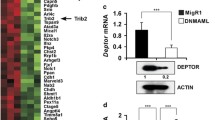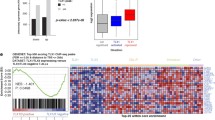Abstract
Active mutations of Notch1 play pivotal roles during leukemogenesis, but the downstream targets and molecular mechanisms of activated Notch1 signaling have not yet been fully clarified. In this study, we detected the overexpression of the high mobility group A1 (HMGA1) and activation of Notch1 signaling in mouse thymic lymphomas. A direct regulation of Notch1 on HMGA1 transcription was demonstrated and two Notch1/RBPJ cobinding sites of T/CTCCCACA were found in HMGA1 promoter regions. It was the first time demonstrated that HMGA1 was the downstream target of Notch1 signaling. Moreover, knockdown of HMGA1 resulted in significantly impaired cell growth and decreased expressions of cyclin D and cyclin E in human T leukemia cells. The formation of complexes was also observed between HMGA1 and retinoblastoma (RB) protein indicating a mechanism of cell cycle regulation. These findings suggest that activated HMGA1 regulates cell proliferation through the Notch1 signaling pathway, which represents an important molecular pathway leading to leukemogenesis.



Similar content being viewed by others
References
Aifantis I, Raetz E, Buonamici S (2008) Molecular pathogenesis of T-cell leukaemia and lymphoma. Nat Rev Immunol 8:380–390
Chen J, Odenike O, Rowley JD (2010) Leukaemogenesis: more than mutant genes. Nat Rev Cancer 10:23–36
Brathwaite O, Bayona W, Newcomb EW (1992) p53 mutations in C57BL/6J murine thymic lymphomas induced by γ-irradiation and N-methylnitrosourea. Cancer Res 52:3791–3795
Kakinuma S, Nishimura M, Sasanuma S et al (2002) Spectrum of Znfn1a1 (Ikaros) inactivation and its association with loss of heterozygosity in radiogenic T-cell lymphomas in susceptible B6C3F1 mice. Radiat Res 157:331–340
Newcomb EW, Steinberg JJ, Pellicer A (1988) Ras oncogenes and phenotypic staging in N-methylnitrosourea and gamma-irradiation-induced thymic lymphomas in C57BL/6J mice. Cancer Res 48:5514–5521
Weng AP, Ferrando A, Lee W et al (2004) Activating mutations of NOTCH1 in human T cell acute lymphoblastic leukemia. Science 306:269–271
Grabher C, Boehmer H, Look AT (2006) Notch 1 activation in the molecular pathogenesis of T-cell acute lymphoblastic leukaemia. Nat Rev Cancer 6:347–359
Osborne BA, Minter LM (2007) Notch signalling during peripheral T-cell activation and differentiation. Nat Rev Immunol 7:64–75
Pear WS, Aster JC, Scott ML et al (1996) Exclusive development of T cell neoplasms in mice transplanted with bone marrow expressing activated Notch alleles. J Exp Med 183:2283–2291
Fusco A, Fedele M (2007) Roles of HMGA proteins in cancer. Nat Rev Cancer 12:899–910
Reeves R, Beckerbauer L (2001) HMGI/Y proteins: flexible regulators of transcription and chromatin structure. Biochim Biophys Acta 1519:13–29
Pierantoni GM, Agosti V, Fedele M et al (2003) High-mobility group A1 proteins are overexpressed in human leukaemias. Biochem J 372:145–150
Fedele M, Pentimalli F, Baldassarre G et al (2005) Transgenic mice overexpressing the wild-type form of the HMGA1 gene develop mixed growth hormone/prolactin cell pituitary adenomas and natural killer cell lymphomas. Oncogene 24:3427–3435
Xu Y, Sumter TF, Bhattacharya R et al (2004) The HMG-I oncogene causes highly penetrant, aggressive lymphoid malignancy in transgenic mice and is overexpressed in human leukemia. Cancer Res 64:3371–3375
Fedele M, Visone R, Martino I et al (2006) HMGA2 induces pituitary tumorigenesis by enhancing E2F1 activity. Cancer Cell 9:459–471
Esposito F, Pierantoni GM, Battista S et al (2009) Interaction between HMGA1 and retinoblastoma protein is required for adipocyte differentiation. J Biol Chem 284:25993–26004
Ueda Y, Watanabe S, Tei S et al (2007) High mobility group protein HMGA1 inhibits retinoblastoma protein-mediated cellular G0 arrest. Cancer Sci 98:1893–1901
Gomez-del AP, Kashiwagi M, Jackson AF et al (2010) Alternative promoter usage at the Notch1 locus supports ligand-independent signaling in T cell development and leukemogenesis. Immunity 33:685–698
Jeannet R, Mastio J, Macias-Garcia A et al (2010) Oncogenic activation of the Notch1 gene by deletion of its promoter in Ikaros-deficient T-ALL. Blood 116:5443–5454
Rao S, O’Neil J, Liberator C et al (2009) Inhibition of NOTCH signaling by gamma secretase inhibitor engagaes the RB pathway and elicits cell cycle exit in T-cell acute lymphoblastic leukemia cells. Cancer Res 69:3060–3068
Reeves R (2010) Nuclear functions of the HMG proteins. Biochim Biophys Acta 1799:3–14
Wang H, Zou J, Zhao B et al (2011) Genome-wide analysis reveals conserved and divergent features of Notch1/RBPJ binding in human and murine T-lymphoblastic leukemia cells. Proc Natl Acad Sci USA 108:14908–14913
Ong CT, Cheng HT, Chang LW et al (2006) Target selectivity of vertebrate notch proteins. Collaboration between discrete domains and CSL-binding site architecture determines activation probability. J Biol Chem 281:5106–5119
Wood LJ, Mukherjee M, Dolde CE et al (2000) HMG-I/Y, a new c-Myc target gene and potential oncogene. Mol Cell Biol 20:5490–5502
Palomero T, Lim WK, Odom DT et al (2006) NOTCH1 directly regulates c-MYC and activates a feed-forward-loop transcriptional network promoting leukemic cell growth. Proc Natl Acad Sci USA 103:18261–18266
Kolb S, Fritsch R, Saur D et al (2007) HMGA1 controls transcription of insulin receptor to regulate cyclin D1 translation in pancreatic cancer cells. Cancer Res 67:4679–4686
López-Nieva P, Santos J, Fernández-Piqueras J (2004) Defective expression of Notch1 and Notch2 in connection to alterations of c-Myc and Ikaros in gamma-radiation-induced mouse thymic lymphomas. Carcinogenesis 25:1299–1304
Dumortier A, Jeannet R, Kirstetter P et al (2006) Notch activation is an early and critical event during T-Cell leukemogenesis in Ikaros-deficient mice. Mol Cell Biol 26:209–220
Schwanbeck R, Schroeder T, Henning K et al (2008) Notch signaling in embryonic and adult myelopoiesis. Cells Tissues Organs 188:91–102
Kakinuma S, Nishimura M, Kubo A et al (2005) Frequent retention of heterozygosity for point mutations in p53 and Ikaros in N-ethyl-N-nitrosourea-induced mouse thymic lymphomas. Mutat Res 572:132–141
Cleynen I, Huysmans C, Sasazuki T et al (2007) Transcriptional control of the human high mobility group A1 gene: basal and oncogenic Ras-regulated expression. Cancer Res 67:4620–4629
Okano H, Saito Y, Miyazawa T et al (1999) Homozygous deletions and point mutations of the Ikaros gene in gamma-ray-induced mouse thymic lymphomas. Oncogene 18:6677–6683
Thanos D, Maniatis T (1995) Virus induction of human IFN beta gene expression requires the assembly of an enhanceosome. Cell 83:1091–1100
Daria D, Filippi MD, Knudsen ES et al (2008) The retinoblastoma tumor suppressor is a critical intrinsic regulator for hematopoietic stem and progenitor cells under stress. Blood 111:1894–1902
Giacinti C, Giordano A (2006) RB and cell cycle progression. Oncogene 25:5220–5227
Acknowledgments
This study was supported by National Natural Science Foundation of China (81070887, 81101538), Grants from South-Central University for Nationalities (YZZ09007 and XTZ10001), and by the K.C. Wong Magna Fund in Ningbo University.
Author information
Authors and Affiliations
Corresponding author
Electronic supplementary material
Below is the link to the electronic supplementary material.
11010_2012_1517_MOESM1_ESM.pdf
Supplementary Figure 1. Notch1/RBPJ cobinding sites of T/CTCCCACA in human HMGA1 promoter region within 2 kb of transcriptional start site (TSS). Two Notch1/RBPJ cobinding sites of T/CTCCCACA were found and underline. The genome sequence was downloaded from the Homo sapiens chromosome 6 genomic contig, GRCh37.p9 Primary Assembly (NCBI Reference Sequence: NT_007592.15)
11010_2012_1517_MOESM2_ESM.pdf
Supplementary Figure 2. Decreased HMGA1 expression in C-MYC knockdwon leukemia cells. Quantitative RT-PCR analysis of C-MYC and HMGA1 expression after siRNA transfected human T-ALL HPB-ALL cells. β-actin was used as the internal control. The mRNA in GL3 siRNA treated cells was normalized to 1. P values (Student’s t test) for the differences between GL3 control and C-MYC siRNA treated samples are indicated. *(P<0.05); **(P<0.01)
Rights and permissions
About this article
Cite this article
Xi, Y., Li, YS. & Tang, HB. High mobility group A1 protein acts as a new target of Notch1 signaling and regulates cell proliferation in T leukemia cells. Mol Cell Biochem 374, 173–180 (2013). https://doi.org/10.1007/s11010-012-1517-2
Received:
Accepted:
Published:
Issue Date:
DOI: https://doi.org/10.1007/s11010-012-1517-2




